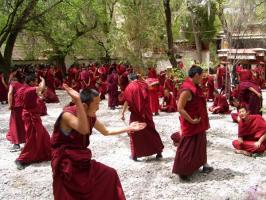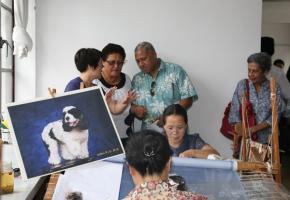Chinese Music
Chinese Music History
The richness of Chinese civilization also finds its energy in a important art form - Chinese music. The origins of Chinese music can be dated back to distant antiquity. Approximately 8000 Chinese Musicyears ago. European music was experiencing its first rustlings of life whereas a complete musical theory and sophisticated musical instruments began to appear in China, owing largely to the orthodox ritual music advocated by Confucius.
The long history of Chinese music started with the earliest wind instruments - 16 vertical bone flutes which were found in Henan province in 1985. Two famous theories saw a splendid Chinese history of over 2000 years' exploration in musical theory. The first complete music theory - Theory of Increase and Decrease in Trisection came into being at the middle of the Spring & Autumn Annals (770 B.C.- 476 B.C.) in ancient China. By the Han Dynasty (206 B.C. - 220 A.D.), the imperial court had set up a Music bureau which was in charge of gathering and editing ancient tunes and folk songs. By the time of the Tang Dynasty (713 - 755 A.D.) the court organized the Pear Garden Academy song and dance troupe which cultivated a large number of musicians, this then laid a firm foundation for Chinese music, and even other music-related art like folk songs, drama, opera. Duodenary Law of Averages, created by Zhu Zaiyu (a royal member) in the Ming dynasty (1368-1644), became a symbol of the highest music achievement in China.
In the course of the development, all kinds of professional musical instruments were produced, classified and used. Lastly, the achievement of music laid a solid base for Chinese and other arts related to music. Let us see the development of music at different historical periods. Remote Antiquity (about 6000 BC - 1711 BC) - At that time, the earliest wind instruments like vertical bone flutes, 'xun' (pottery musical instrument) were used to play as accompaniment to singing and dancing in hunting activity. Also, some percussion instruments were put into use.
Early Qin (1711 BC - 256 BC)- Chinese music reached the first height during this period. Percussion instruments such as carillons, bronze bells, drums and Qing (instrument made of metals or stone chimes) were popularly used in playing music. The instruments feature grandeur sound effect and ringing sonority of produced grand features for Chinese music. Then stringed Chinese Musicinstruments like ancient Qin and Se (a twenty-five-stringed plucked instrument, somewhat similar to zither) came out as a kind of solo tool. In the Chou dynasty (c. 1027-256 BC) music was one of the four subjects for noble man to study. Although much of the repertoire has been lost, some old Chinese ritual music ( Yayue ) is preserved in manuscripts.
Qin to Tang Dynasty (221 BC - 960 AD) - During the Qin dynasty (221-206 BC) music was denounced as a wasteful pastime; Almost all musical books, instruments, and manuscripts were ordered destroyed. Despite this severe setback Chinese music experienced a renaissance during the Han dynasty (206 BC-AD 220), when a special bureau of music was established to take charge of ceremonial music. Here came a full height of Chinese music. A number of musical instruments were introduced into China from foreign country because of cultural exchange. The wide spread of stringed instruments and music notes for stringed instrument made Chinese secular music ( Suyue ) reach its peak at that time. Pi Pa played a leading role in royal/imperial court music which was typical form in Tang dynasty (618-906). At the end of this period, one of the most important Chinese musical instrument - Er Hu (in Chinese Pinyin, means two-string instrument) came out.
Song to Qing Dynasty (960 - 1840) It is a very important time for bow and string instruments. The wide use of the instruments promoted the development of Chinese drama and opera. The operas were based on old tales of heroes and the supernatural. The first fully developed form of Chinese opera, called northern drama, or Beiqu, emerged during the Yuan dynasty (1279-1368). During the Ming (1368-1644) and Qing (1644-1912) dynasties, southern drama, also called Xiwen, flourished and underwent much stylistic development. The variety of Chinese opera known as Peking opera, Jingxi, is the most familiar in the West. It developed in the 19th century as a synthesis of earlier provincial forms. Moreover, with the occurrence of Suona (a kind of wind instrument) and gong such kinds of instruments, folk music came into popularity instead of court music.
Contemporary Period (1912 - now) During the first half of the 20th century Chinese music was considerably influenced by the music of the West. Three major schools of thought arose in response to this influence. The first school aimed at reviving the old thousand-piece orchestras that once delighted ancient princes and sages and resisted the influence of Western music. Chinese MusicThe second school concerned itself almost exclusively with Western music. The last school of Chinese music took great pride in traditional Chinese musical culture but did not hesitate to apply it to Western techniques of composition and performance.
During the 1950s Western influences penetrated Chinese music to an unprecedented extent. In contemporary China notable facilities exist for the training of musicians in both Chinese and Western styles. Many symphonic orchestras and Chinese-style instrumental ensembles exist, and large choral groups are commonly found in large cities, universities, and factories. Both Chinese and Western instruments are manufactured in large quantities and are used in government-maintained schools and conservatories throughout the country.
Philosophy and Characteristics of Chinese music
For several thousand years Chinese culture was dominated by the Confucianism, Taoism and Buddhism. Chinese people believe that sound influences the harmony of the universe and the power of vocal and instrumental music composed and played in the highest sense to purify one's thoughts, calm the passions, to dispel unrest and lust, rather than as a form of amusement. All such a particular expression can be found in the cult of the qin and flutes.
First, Chinese music is somehow related to the tonality of Chinese language. Thus melody and tone color are prominent expressive features of Chinese music, and great emphasis is given to the proper articulation and inflection of each musical tone. The same pronunciation with different tones represents different meaning, depending on whether it is a flat tone, or sliding from a lower to higher pitch or from the higher to the lower, or a combination. There is same thing for Chinese music, thus it has more possibilities in tonality which is more sensitive andChinese Music subtle.
Most Chinese music is based on the five-tone, or pentatonic, scale, but the seven-tone, or pentatonic, scale, is also used, often as an expansion of a basically pentatonic core. The pentatonic scale was much used in older music. The pentatonic scale is often encountered in northern Chinese folk music.
Secondly, Classical Chinese music refers to the art music closely related with Chinese poetry. Therefore, it is not surprising that most of the classical pieces have very poetic and sometimes philosophical titles. Traditional classical music in this sense is intimately linked to poetry and to various forms of lyric drama and is more or less poetry without words.
Thirdly, Classical Chinese music and traditional Chinese painting are twin sisters. Take, for instance, the traditional painting for landscapes: there is no obvious focus in the picture, but each part seems to have its own focus in such a manner that the variety of local character is in harmony with the whole picture, including the empty parts.
In traditional Chinese painting, the empty parts are very important too in order to give the whole painting life. If everywhere were painted, there would be less freedom of imagination forChinese Music the viewers in appreciating the painting. In another words, the appreciating of painting is an interactive and dynamic process between the viewers and painting. The same is true with classical Chinese music. Each phrase is one sentence followed by a certain silence in such a way that the variety of sounds and the silences (and sometimes noise) are combined harmoniously in forming the sound poetry, creating a kind of dynamic link between the performer and the audience. A good performer can create such a link so that the listeners can experience the power and the beauty of the music in a way like enjoying a beautiful poems and painting.
Traditional Chinese Musical Instruments
According to Ba Yin Method - the classification of materials used in their construction, Chinese musical instruments traditionally have been grouped into eight kinds: metal (carillons, bronze bells), stone chimes (Qing), pottery/clay (xun), leather/skin (drum), strings/silk(se, qin and cheng), wood, guard, and bamboo(flutes, yu, sheng). Of these, the stone and wood instruments are obsolete. The older instruments include long zithers; flutes; panpipes; the sheng, or mouth organ; and percussion instruments, such as clappers, drums, and gongs. Of later origin are various lutes and fiddles, introduced to China from Central Asia.

.jpg) Chinese Food Culinary Tours
Chinese Food Culinary Tours China Tours for Religions
China Tours for Religions Accessible China Tours
Accessible China Tours

